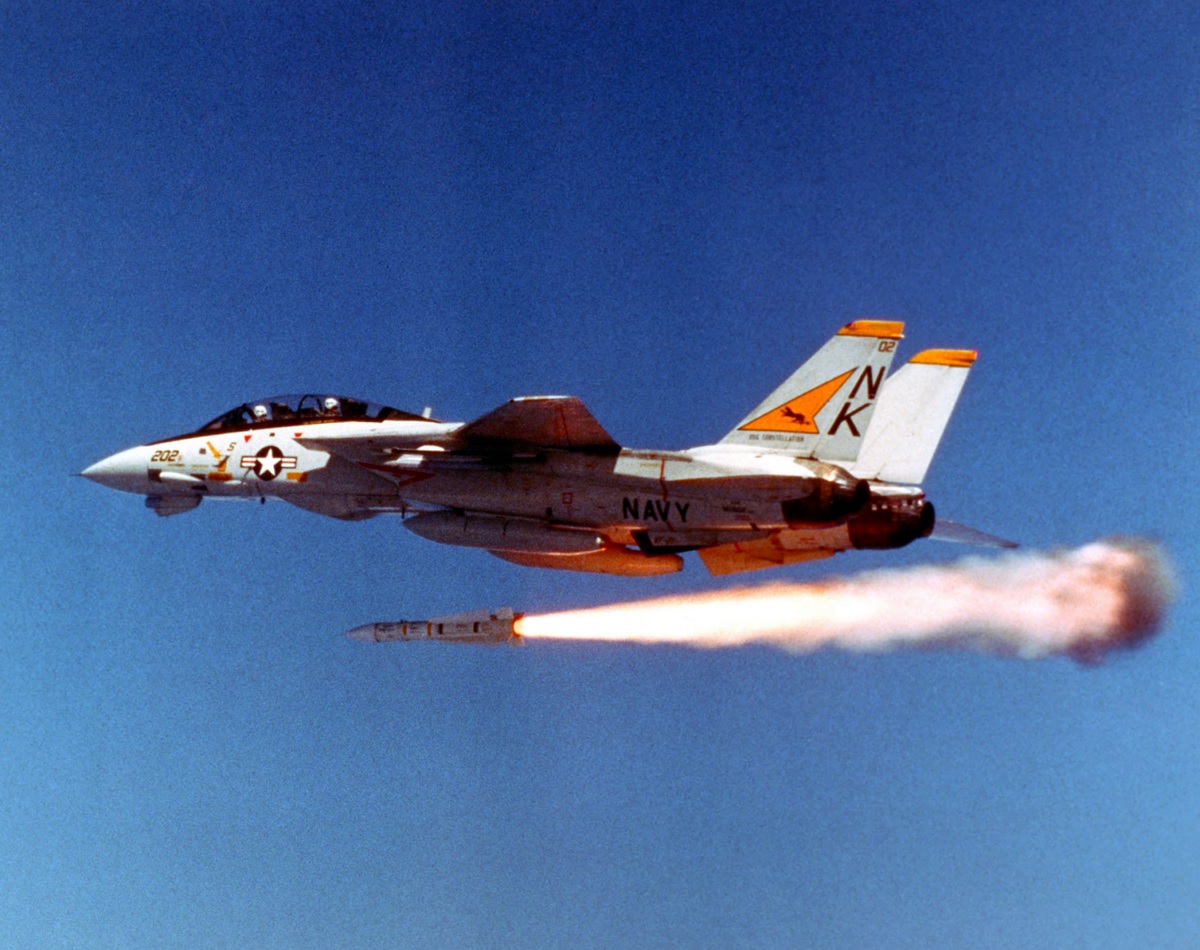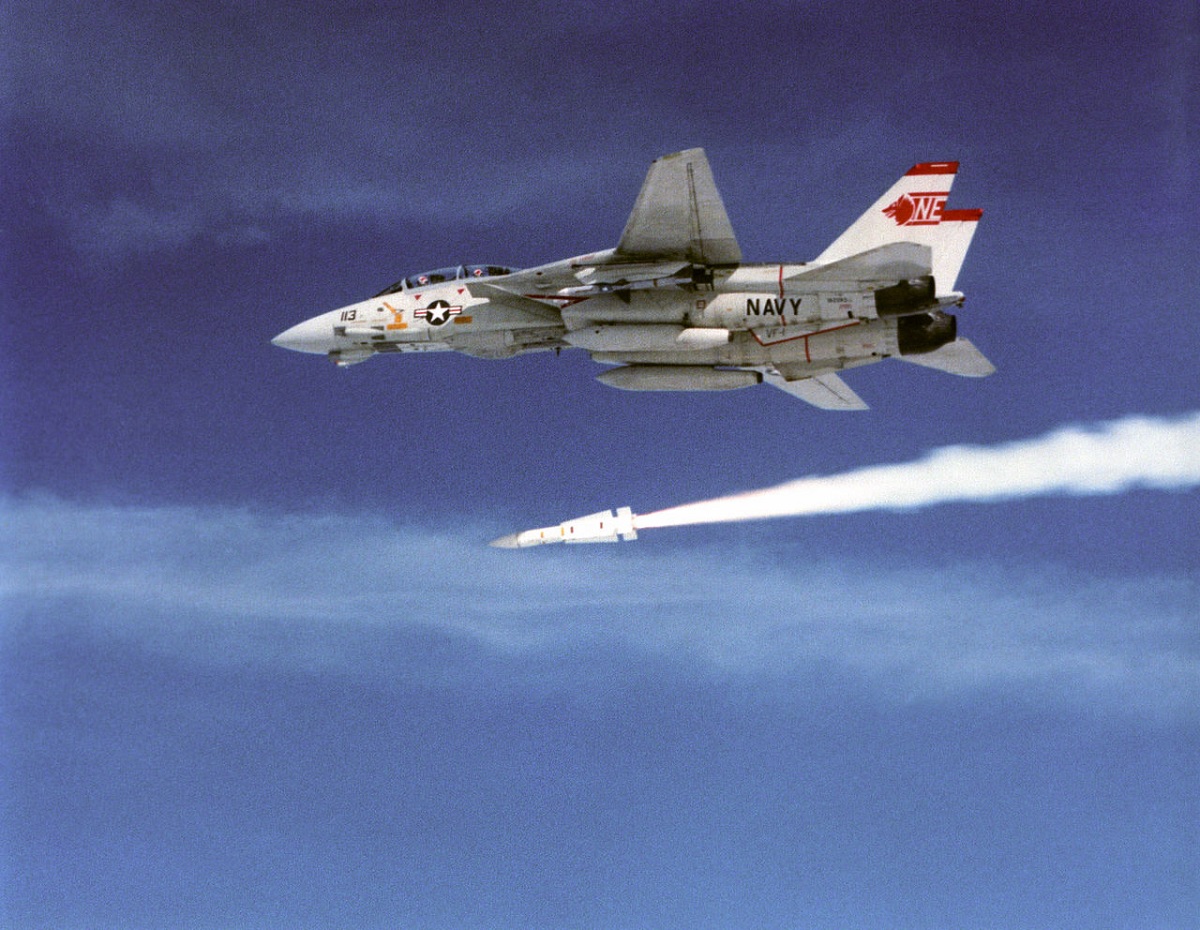The six-on-six missile shoot was seen as a major success because it showed that the AIM-54 Phoenix missile and the F-14 Tomcat were both ready for active service
The F-14 Tomcat, designed toward the end of the 1960s as a multimission fighter capable of both dogfighting against the most agile fighters and defending U.S. Navy Carrier Battle Groups (CVBG) from raids carried out by Soviet bombers armed with long-range cruise missiles, was equipped with the AWG-9, the most powerful radar ever mounted on a fighter.
The AIM-54 was the largest, deadliest, and longest-range air-to-air missile in the world out of all the weapons that the AWG-9 could support. The Phoenix corrected many flaws in the earlier missiles and added a number of new capabilities, including those that were present in the AIM-7 Sparrow.
As detailed in the book Tomcat! The Grumman F-14 Story by Rear Admiral Paul T. Gillcrist, the first advancement made by the AIM-54 was a significant increase in range from the Sparrow’s 15 miles to an astonishing 100 miles (160 km). As a result, the Phoenix was the perfect weapon to counter the threat posed by Soviet bombers and their cruise missiles. The second new capability introduced by the AIM-54 was strictly linked to its radar: the AWG-9 had the unprecedented ability to track 24 targets and attack 6 of them simultaneously.
The F-14 was the first fighter in the world to be able to engage several aerial targets at once thanks to its armament system. Once more, the Phoenix was the first “fire and forget” missile, making it unnecessary for the Tomcat to maintain radar lock on the target while the AIM-54 was flying in its direction. This capability was made feasible by the tiny Phoenix radar, which guided the missile in its final moments of flight. The fourth innovation was the AIM-54’s strong resilience to countermeasures, a crucial quality in any contemporary air-to-air combat situation.

Instead, the so-called “end game,” which is essentially when any other missile, after its rocket motor has burned out, starts to lose speed quickly, providing the target with the chance to maneuver and lowering the probability of the missile’s kill. This was the most significant flaw that the Phoenix system solved.
The Phoenix’s “end game” performance has significantly improved as a result of its unusual trajectory following the launch. The AIM-54 rocket motor reached 80,000 feet at a speed between Mach 4 and Mach 5 because it performed better at high altitudes. The Phoenix began to descend when the rocket motor failed, transforming the altitude into velocity and keeping its ability to turn against a moving target.
An extensive test campaign was carried out between 1972 and November 1973 to evaluate the performance of the new Phoenix capabilities. Even though this test campaign resulted in the most expensive series of air-to-air missile test firings in history, it was necessary to show off the power of the Tomcat weapons system as well as to determine the fate of the F-14 since it was designed around the AIM-54 concept.

Two aircraft, the F-14A-15-GR, BuNo 157983 (the fourth Tomcat built), and the F-14A-40-GR, BuNo 157988 (the ninth Tomcat built), participated in the live missile firing program.
On April 28, 1972, Tomcat began firing AIM-54 missiles at various (simulated) targets, including cruise missiles, high-altitude bombers, and fast-maneuvering fighters. One shot was also fired from a very far distance—120 miles (193 km)—when an F-14 engaged and shot down a target drone.
On November 21, 1973, when the infamous “six-on-six missile shot” occurred, the final test was carried out. The Pacific Missile Test Center, formerly known as the current Naval Air Warfare Center, was based at Point Mugu. On that day, Commander John R. “Smoke” Wilson Jr. and his Radar Intercept Office (RIO) Lieutenant Commander Jack Hawver, the crew who carried out the entire Phoenix test campaign, took off from there with their F-14 equipped with a full Phoenix load: four were on pallets in the semi-submerged wells in the underside of the fuselage, and two more AIM-54s were mounted one on each wing station pylon. This time, they had to fire six missiles at six distinct targets simultaneously.

Wilson and Hawver launched all six missiles in 38 seconds once they reached a height of 25,000 feet. Three QT-33s (the drone version of the old jet trainer), two BQM-34A aerial targets, and one BQM-34E were the targets for the AIM-54 missiles. Wilson fired the first Phoenix missile, followed by Hawver with the second through fifth missiles, and then Wilson once more with the final AIM-54.
Four targets, which were simulated bombers (two QT-33s, one BQM-34A, and one BQM-34E), were hit directly while the missiles were flying in unison under the supervision of the Tomcat’s fire control system. The Phoenix radar broke the lock on the other BQM-34A due to a failure at the flight control module, and the final AIM-54 missed the final QT-33 due to a Phoenix radar antenna malfunction.
The test ended with a score of four direct hits, with one AIM-54 missing its target due to the BQM-34A avionics failure, as the following video (which is the original six-on-six missile shot clip) demonstrates.
The six-on-six missile shoot was seen as a significant success because it showed that the AIM-54 Phoenix missile and the F-14 Tomcat were both ready for active service.
Photo by U.S. Navy

